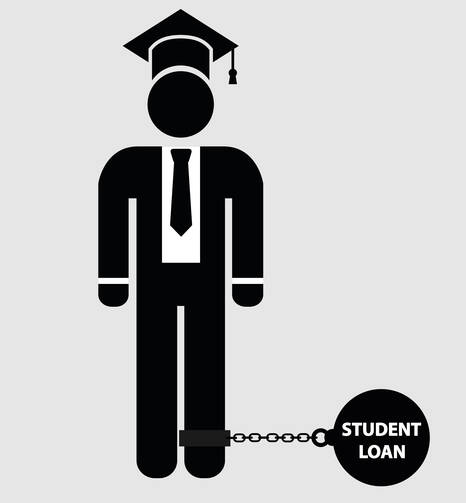In 1965, President Lyndon B. Johnson signed the Higher Education Act. Part of Johnson’s Great Society agenda, the legislation was created as a way to lessen the economic divide between poor and rich American families by providing better financial support and resources for lower-income students seeking higher education. Fifty years later, however, with rising tuition costs and a rapid increase in student loan burdens discouraging working- and middle-class college aspirations, that divide threatens to become unbridgeable.
The current federal student loan debt is over $800 billion. As of 2012, the average loan balance for borrowers of all age groups is $24,301. The skyrocketing cost of tuition, which has risen far in excess of the rate of inflation, is a major contributor to the uptick in borrowing.
Research shows that upon graduation, many borrowers—who make up 60 percent of the graduating class nationwide—are struggling to make timely payments. Recent graduates, who often lack the lucrative job offers and competitive salaries obtained by their predecessors, have very few options if they cannot make their payments. Once the deferment period ends—usually six months after graduation—borrowers must begin making payments immediately. Many recent graduates can make only minimum payments while interest accrues; most outstanding student loans have interest rates of nearly 7 percent or higher. Unless a borrower meets specific requirements, like economic hardship or a high credit score rating, there is little to no consumer protection available. Unlike mortgage and car payments, student loans cannot be refinanced.
Millennials have been hit the hardest. Burdened by student debt, millennials are putting off large purchases, like houses and cars. An article in The Atlantic last October states that home ownership among millennials has reached a 19-year low. A recent study by the Pew Research Center also finds that Generation X-ers (now in their 30s and 40s) who have outstanding loans are likewise affected by the lingering weight of student debt. Those who took out college loans have less wealth than their parents had at the same age, which makes it more difficult for them to save for retirement, investments or their children.
What is being done to address the problem? In 2013, Congress passed the Bipartisan Student Loan Certainty Act, which allows students who took out loans in the 2013-14 school year to pay an interest rate of 3.86 percent on their loans. Senator Elizabeth Warren, Democrat of Masssachusetts, proposed the Bank on Students Emergency Loan Refinancing Act. Under this proposal, students would be given the opportunity to refinance their debt at current government-subsidized rates (less than 4 percent). Senator Warren added that these lowered rates “would be paid for via higher taxes on top earners.” Congress initially rejected Warren’s plan in 2014; the senator hopes to push it through this year.
Loan relief is a good first step, but better financial information should also be provided for students so they understand the implications of the agreements they are making as college freshmen. Universities and colleges with huge endowments could also consider following the Stanford University model; the university now offers free tuition for families making less than $125,000. While not all schools can afford to be so generous, it is incumbent on administrators everywhere to look for creative and prudent ways to contain the cost of a degree.
Catholic colleges also have a special responsibility to offer affordable education for low-income students. Patricia McGuire, president of Trinity Washington, explained in an interview with America that although her school’s endowment is only $14 million, Trinity is able to provide its students with $10 million worth of tuition discounts. She says that particular attention is given to so-called Dreamers, undocumented immigrants brought to the United States as children.
Many students opt out of attending college because they cannot afford tuition costs and fees; others do not see a four-year degree as a significant reason to overburden themselves with student loans. But the competitive global economy of the future will demand some level of post-secondary education, and study after study has documented the importance of a four-year degree to long-term wealth creation. Young people in the United States should not be hamstrung from the start of their working lives because they are trapped by unreasonable debt.
The decision to pursue higher education should pay dividends for all members of U.S. society, not merely the banks or the government. As Pope Francis urged on Palm Sunday in his message for World Youth Day, we must encourage our youth “to be revolutionaries” and “to go against the tide.” What better way than through education, preferably one they can afford?








